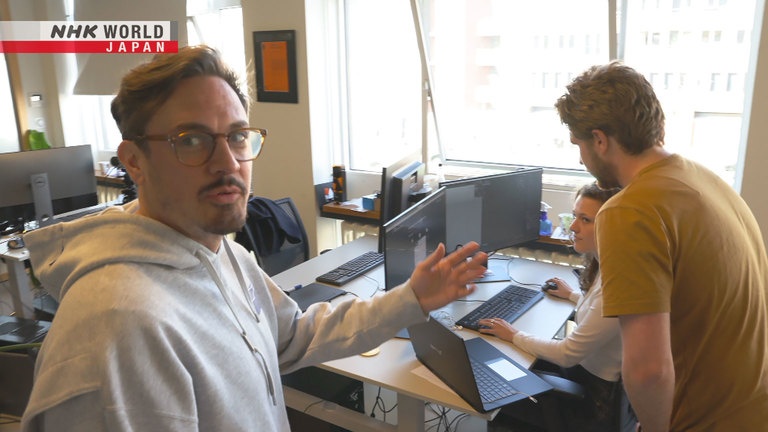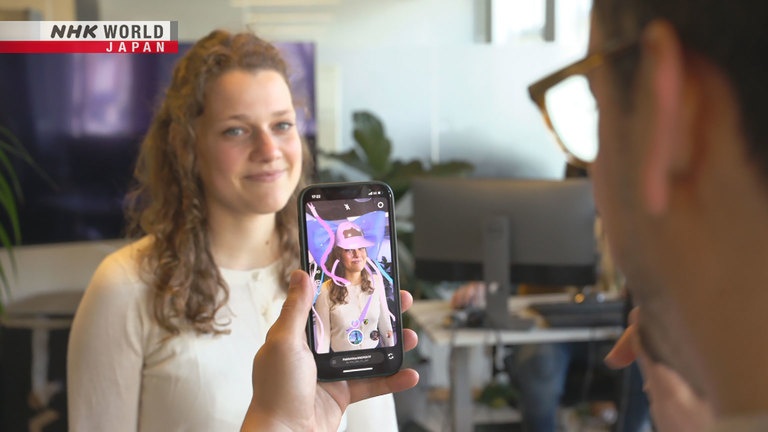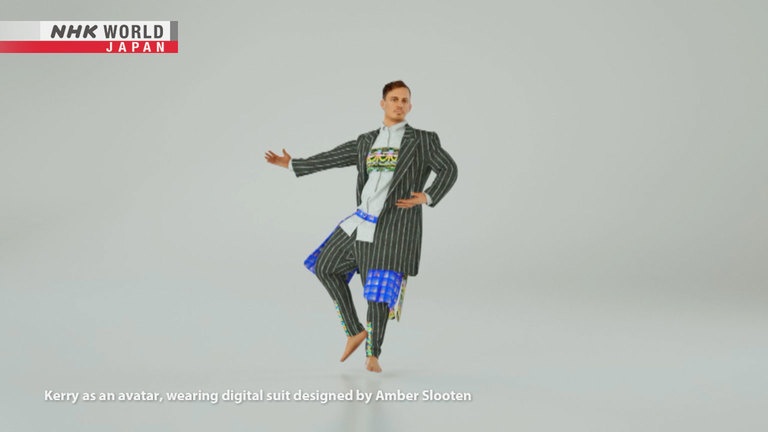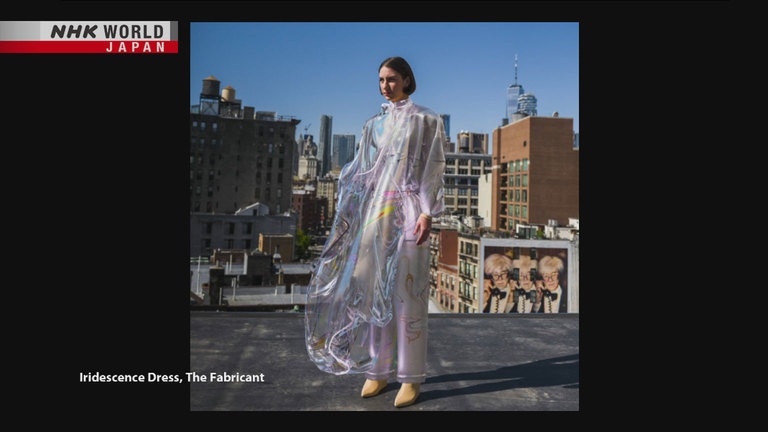A Digital Revolution in Fashion: Kerry Murphy / Co-Founder & CEO of The Fabricant
Trendsetter Kerry Murphy co-founded a digital fashion house. Digital fashion is now mainly used by Gen Z for self-expression on social media and in the metaverse, but the market is expanding.




Transcript
Direct Talk
A scarf with a pattern of a streaming poem.
A burning shoe.
These are designs for digital fashion,
a revolution in the fashion industry.
One of the leaders of
this revolution is Kerry Murphy,
the co-founder of the
world's first digital fashion house.
Digital fashion is fashion
that's only ever digital and not physical
and not keeping our physical bodies warm.
So we're all about creativity,
all about storytelling.
Their main battlefield is the "metaverse,"
where online users' personal avatars
interact with one another.
The market is expected to expand
as more people purchase
digital clothing for their avatars
to express themselves in the metaverse.
Major fashion brands are scrambling
to enter the market to be part of this trend.
Morgan Stanley projects
that the luxury-branded NFTs,
including that of digital fashion,
could become a 56 billion-dollar market by 2030.
So how will the
future fashion industry turn out?
We asked the trendsetter for his perspective.
A Digital Revolution in Fashion
The office of the
digital-only fashion house is
in the heart of Amsterdam in the Netherlands.
Hello. Welcome to The Fabricant.
This is our digital fashion atelier.
A staff of only three
were working here today,
but The Fabricant actually
has more than 60 employees worldwide
who collaborate online
to create digital clothing.
The designs of their digital products
are too complex and detailed
to be reproduced in physical form.
It's really actually,
you know, really in the details,
you know, create stitches
that cannot exist in real life,
create patterns.
It can be like ten different layers
that go into the garment itself,
that's something that
you cannot actually possibly wear.
It would not be able to move on the body.
It's really looking at
what is traditional fashion craftsmanship
and how can we challenge that
with digital-only fashion to create items
that you'd never be able to
replicate from digital to physical?
Unconstrained by physical boundaries,
their designers are
creating digital items full of
creativity, imagination and stories.
Murphy says that these features are highly
valued when it comes to virtual identity
and how people express themselves online.
We're not focused on covering your body,
but we're really focused on
that virtual identity side of things,
and it really comes down to how you
want to portray yourself in the world.
Identity is extremely important
in digital fashion,
but also in traditional fashion.
You know, like for me,
most people are still buying fashion
because of the identity perspective.
It's even if we choose to buy
very plain white T-shirts or black T-shirts,
it's a form of storytelling.
So once you've bought
yourself a digital outfit,
how can you actually wear it?
There are several ways to do it.
One is to have a photo of yourself
overlaid with a digital outfit,
and you can share the image
on your social media.
Another is to use AR, augmented reality,
to see yourself moving around
wearing it on your smartphone.
And, of course,
your personal avatar can wear it
across various compatible platforms
in the metaverse.
To ensure ownership and authenticity
for the designers' digital items,
you can record them on the blockchain
and even sell them if you want.
But do people really find
digital-only clothing worth buying?
Our customers,
even our investors,
some of my friends,
a lot of them were like,
it's like, that's stupid.
Why would anybody want that?
But once they start seeing of
how people actually were using it,
for instance, Italian celebrity,
who creates a lot of Instagram content
and typically has to have a lot of clothing,
buying a lot of clothing
to constantly keep churning out
more and more content for social media.
She realized that by digital solutions,
she doesn't have to buy
or use any physical items.
She can be constantly
just recreating digital looks.
So there was this one thing
where she was wearing a fur coat
together with the flaming shoes.
Well, with the flaming shoes,
you could see that, hey, these are not real,
but nobody actually
paid attention to the fur coat,
that the fur coat was actually digital,
you know, so there was
no actual animals being harmed.
It was not fake.
So that's the power that we really
focused on with that project.
The main customers of The Fabricant
are typically women in their 20s
who care about fashion.
For these digital natives,
self-expression on the Internet is
as important as sustainability
in the fashion industry.
That's where digital fashion comes in
to play an important role for them.
For your information,
the video version of these burning shoes
was sold for $60.
To cater to young shoppers,
luxury fashion brands offer digital items
at a reasonable price range
compared to their physical products.
On the other hand,
for those who don't have
social media accounts
or who don't play online games,
the concept of digital fashion
is inconceivable.
My grandparents, they're very old.
They don't care anything
about digital fashion but
the good thing is like
their favorite newspaper in the UK
because they live in the UK
has done a lot of coverage
about me and the company itself.
So when they first saw like an article
in their favorite newspaper of what we do,
that's when it's like
they still don't understand it.
But if the newspaper writes about it,
it must be true!
Murphy thinks that once the technologies
around the metaverse evolve further,
it will become the new norm for people to
wear digital clothing in their everyday life.
Where we're heading towards to is this
whole idea of the wardrobe of the metaverse.
So, for instance, when you have like
Zoom calls or video calls in your meetings,
you can be wearing digital-only clothing.
I just wake up in the morning
and I'm still in my pajamas
and I need to jump into this meeting.
I just quickly click on a digital-only suit
and I don't have to put on
any physical clothing!
So this is this like number one request.
I don't know if they would
actually want to have that,
but the idea is correct right there
that you have this flexibility
to choose your digital-only clothing
when you're in these
different metaverse places.
Kerry Murphy was born in the
small town of Hollola in Finland in 1982.
He grew up with the Nordic values of
sustainability and social welfare
He says that high school
was not a great fit for him,
but the video camera
his mother gave him around that time
changed his life.
I just used the camera
as a tool to express myself
to express my stories.
That's what I really needed in my life,
because I never really was good at anything
other than just being my stubborn self.
After that realization,
Murphy chose a career in the film industry
and worked as a motion designer
for about 10 years in the Netherlands.
During that time, he met Amber Jae Slooten,
and they decided to launch a new
digital fashion business together in 2016.
The idea with the digital fashion house
was a no-brainer.
It was very, very easy to come up with.
The physical fashion industry
is extremely unsustainable,
and you can't keep running it
as it is right now in the long term.
And secondly, nobody had done
digital fashion house at that point.
Nobody,
You know, all design industry has
gone through a digital transformation.
So you just know that it's going to happen
in fashion sooner or later as well.
I'm a creative person.
My co-founder, Amber is a creative person.
So we were extremely excited about that idea.
Their different respective
expertises coalesced
as they experimented
with digital fashion technology.
That's what I did back in 2017
with some kind of motion capture.
This was really crazy stuff we tested,
trying to understand
how well does it hold technically.
Murphy cannot forget how he felt
when Slooten put the digital clothes
on his avatar for the first time.
She put this, weird kind of a
half-female, half-male suit,
like let's call it a gender-fluid suit on me.
And my first reaction was like,
"Oh, my God, I would never
wear that in my physical life."
But then my second reaction was like,
"Well, why not?"
Because there I don't have those limitations.
The virtual space is a safe space
for exploration within your identity.
And then the next thing that
happens to you is start thinking of like,
"Hey, what am I actually wearing
in my physical life?"
How, you know, like
"What are the different risks
that I want to take?"
"What are the different stuff
that I might want to try out?"
So for me, digital fashion is
one big part of the fashion future,
simply because it removes
a lot of the limitations.
However, this exciting new business
faced some big challenges.
The biggest challenge was
business model.
How are we going to monetize it?
How are we going to actually
survive on making digital fashion?
While exploring options,
Murphy reached out to the gaming industry,
but it did not show much interest.
On the other hand, the fashion brands
welcomed the idea with open arms.
The timing couldn't have been better.
They were screaming for change,
but they didn't know
what that change was. Right.
So early on, when I started showing
the visualizations that we created in 2016,
the fashion brands just was like,
Oh my God, I need this.
I need this right now
without even knowing what it meant.
That is because the fashion industry's
environmental problems
were being widely criticized.
By adopting digital technology
in the design and manufacture processes,
it could reduce not only
clothes and textile waste
but also its overall environmental impact.
While collaborating with
traditional fashion brands
to establish digital transformation,
The Fabricant pursued
its own fashion label and digital couture.
Then in 2019, history was made
when The Fabricant sold the
world's first-ever digital fashion NFT
for $9,500.
A lot of the press headlines was like,
"Why would anybody buy a
digital-only garment for almost $10,000?"
A lot of the criticism
was based on a fairy tale story,
"The Emperor's New Clothes,"
where the Emperor is sold
these invisible clothes,
and he likes to walk around naked
around his town
thinking he's wearing invisible clothes.
However, this is, again,
a very different context.
It's not to cover the body.
It's really about the virtual identity side.
I always call that that in 500 years from now,
we're going to look at this moment
as the first time that
digital-only fashion was sold
when then it's going to be completely normal.
You know, people, nutty people
are going to be thinking then it's like,
"Why did everybody have such
big closets of physical clothing
that they never used,
that they only used maybe
10, 20% of those clothes in the closet?"
And it was a milestone moment
for this and this this reason.
Kerry Murphy
Co-Founder & CEO of The Fabricant
Now Murphy is committed to
starting another revolution:
to build a new fashion industry
that belongs to none other than the creators.
This platform enables anybody
to participate and co-create
their own digital fashion.
The users choose a garment,
customize the fabric, add colors,
and mint their own NFT for sale.
And you can be setting up
your own fashion stores in the metaverse.
We want to create equal chance
for anybody else in the world,
in the fashion industry,
as any kid in Paris who are
going to a traditional fashion school.
Everybody with access to Internet
should have an equal chance
like anybody else in this world
to participate and profit
from the economy itself.
A single mother who used this platform
left this note on
The Fabricant Studio's website.
"I don't have these types of
privileges in my physical life.
But this ecosystem
is enabling for me to have my lifelong
ambition of becoming a fashion designer."
If this one person says that,
you know, and that's kind of like
that moment where, like,
you know, it just touches your heart
and just warms you up so much.
And for me,
purpose is the most important thing
when it comes down to the work.
You know, like
digital fashion might be gimmicky,
what we do might be funny to many,
but if it's actually affecting
people's lives in a positive way,
then I feel like, you know,
must be something good in it.
We asked Murphy to tell us his motto.
To change culture,
we need to change the matrix
of stories told in our society.
The most powerful person in society
is the person who knows how to tell stories.
So I believe that using stories,
that's the way we form culture.
This is the starting point of
something extremely large to become.
It might be ludicrous to say that right now,
but it's going to be the most normal thing.
Five, ten, 20, 30,
200 years from now.
I don't know.
Sooner or later, we'll see.
To change culture, we need to change
the matrix of stories told in our society.